Note: This article was originally published in the April 1993 issue of Rider.
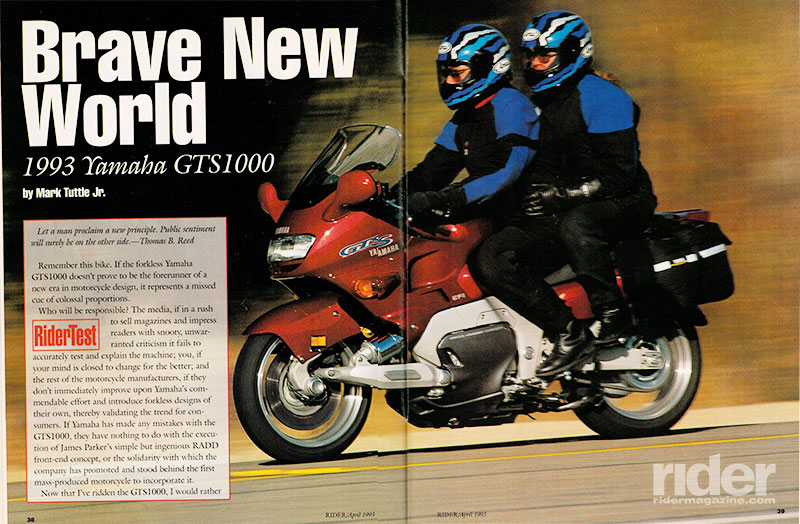
Let a man proclaim a new principle. Public sentiment will surely be on the other side. -Thomas B. Reed
Remember this bike. If the forkless Yamaha GTS1000 doesn’t prove to be the forerunner of a new era in motorcycle design, it represents a missed cue of colossal proportions.
Who will be responsible? The media, if in a rush to sell magazines and impress readers with snooty, unwarranted criticism it fails to accurately test and explain the machine; you, if your mind is closed to change for the better; and the rest of the motorcycle manufacturers, if they don’t immediately improve upon Yamaha’s commendable effort and introduce forkless designs of their own, thereby validating the trend for consumers. If Yamaha has made any mistakes with the GTS1000, they have nothing to do with the execution of James Parker’s simple but ingenious RADD front-end concept, or the solidarity with which the company has promoted and stood behind the first mass-produced motorcycle to incorporate it.
Now that I’ve ridden the GTS1000, I would rather not go back to forks. True, the telescopic fork has reached a very competent level of development, even with some of the cost-effective designs on street motorcycles. Yet, even at their best, street motorcycle forks suffer from flex in torsion and seal stiction, to say nothing of bump steer and changing the motorcycle’s chassis geometry during acceleration and braking. Fork designs that minimize these handicaps are expensive. Wouldn’t it make more sense to invest that money into an alternative, even a fledgling one, that doesn’t–can’t–possess any of those problems?
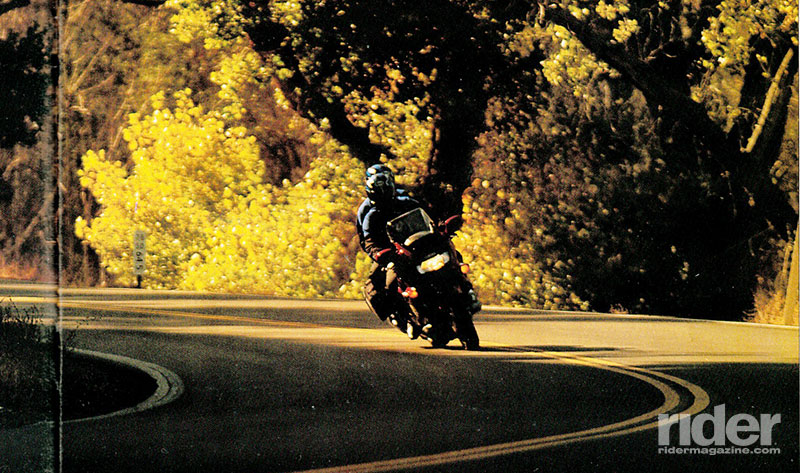
For a complete description of the GTS1000’s front end and an interview with inventor James Parker, see the technical analysis in Rider, December 1992. For the purposes of this road test, if you consult the illustrations you can see that the GTS1000’s front end is essentially a parallelogram formed by the bike’s frame on one side, a case upright on the opposite side, a single-sided swingarm on the bottom and an A-arm on top. The wheel pivots on a kingpin at the end of the hooked-shaped swingarm, and steering input is accomplished by a telescoping cylindrical unit mounted between the handlebar and the top of the upright. With a shock absorber mounted between the lower arm and the chassis, the wheel can move more or less vertically while the chassis remains stationary.
In theory the single-sided swingarm front-end design of the Yamaha GTS1000 (which, together with the bike’s twin-beam frame and rear swingarm, Yamaha calls the Omega Chassis Concept, after the last letter in the Greek alphabet) eliminates all of the handling quirks associated with a telescopic fork, and presents several opportunities. The widely spaced front swingarm pivots spread side and torsional loads over a wider area than traditional steering heads, greatly enhancing rigidity. Bump steer–the tendency of the front wheel to steer the motorcycle as it moves through the suspension travel–is absent since the front suspension is independent of the structure which steers the front wheel. The trail figure for best handling may be set virtually at will, and changes to it and the bike’s wheelbase will be minimized during braking and acceleration. The design is inherently anti-dive as well, since the disc brake caliper is rigidly bolted to the upright. Braking torque from the spinning rotor thus tends to push down on the axle and extend the shock, canceling the forward weight transfer trying to compress it.
The steering component of this design also requires little space and can be located anywhere within a pretty large area, giving Yamaha more freedom in the placement of critical parts such as the steering head, seat and gas tank. For its first marketing foray into the forkless unknown, Yamaha chose to give the GTS1000 a rather conventional sport-touring ergonomic layout, though the RADD front-end design leaves the future wide open for more radical seating positions.
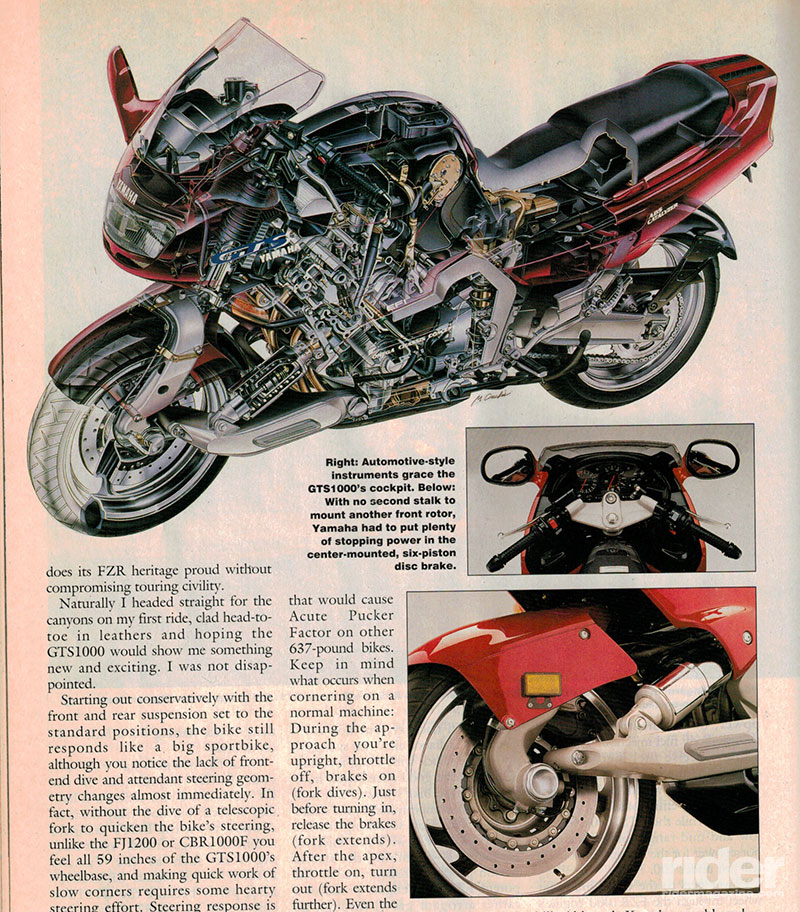
Removing the GTS1000’s bodywork reveals the main twin-beam frame, which fully supports the engine and running gear without the usual backbone or steering head. Except for cast footage and muffler hangers which taper rearward, the rest of the motorcycle’s components–including the fairing, tail section and seat–are supported by bolt-on tubular-steel subframes that extend up and to the front and rear of the GTS1000.
In the near future we could see engine cases with cast-in supports for the front and rear swingarm pivots, eliminating the need for other than small subframes. Not one to bite off too much at once, however, Yamaha used its existing liquid-cooled, 1,002cc FZR1000 transverse in-line four in the GTS1000. The hard-charging, DOHC, 20-valve Genesis mill is nicely enhanced for sport-touring, with lower compression, smaller head pipes and suitable cam timing for mid-range power, not to mention electronic throttle-body fuel injection. The latter allows precise fuel metering and enables the use of a closed-loop catalytic converter, which Yamaha claims helps reduce emissions by 60 to 70 percent. While the GTS1000’s forte is low- and mid-range torque, claimed horsepower for the European model is still just under 100.
Power gets to the GTS1000’s rear wheel through the FZR1000 engine’s five-speed transmission and chain final drive, all the gear ratios of which are unchanged. Since this transmission was designed to spin a chain, going with a “corrected” shaft drive more suited to sport-touring (a la BMW’s Paralever) would have been too costly. For $12,999, you can have front or rear suspension trickery, but not both. Yamaha’s Deltabox alloy rear swingarm and single shock with rising-rate linkage are pretty good alternatives, however, and the bike’s power and handling are uncompromised by the chain.
Once you stop searching for the GTS1000’s choke–it’s fuel-injected, remember?–thumbing the starter button produces instant results. The potent FZR1000 engine produces a rather arrogant growl through its four-into-one pipe, but the fuel injection has it so well tamed you can ride off immediately without a sputter. In typical sport bike style first gear is tall, and the clutch engagement band on our test bike was somewhat narrow. Combined with some trepidation about the strange front end these things make starting out a little wobbly at first.
Once the newness has worn off, your initial impression of the GTS1000 is not how differently it handles or feels, but how truly familiar. Around town the bike’s manners remind of a large, friendly sport-touring bike such as the Yamaha FJ1200/ABS or Honda CBR1000F/LBS, partly because the GTS1000 only weighs 14 and 32 pounds more respectively than these forked, carbureted machines. It has excellent low-speed handling, lots of smooth bottom-end power and more mid-range and top-end performance than the average rider needs. Although it runs out of steam quickly near its 10,500-rpm redline, the GTS1000’s engine does its FZR heritage proud without compromising touring civility.
Naturally I headed straight for the canyons on my first ride, clad head-to-toe in leathers and hoping the GTS1000 would show me something new and exciting. I was not disappointed.
Starting out conservatively with the front and rear suspension set to the standard positions, the bike still responds like a big sportbike, although you notice the lack of front-end dive and attendant steering geometry changes almost immediately. In fact, without the dive of a telescopic fork to quicken the bike’s steering, unlike the FJ1200 or CBR1000F you feel all 59 inches of the GTS1000’s wheelbase, and making quick work of slow corners requires some hearty steering effort. Steering response is instantaneous though, and the trade-off comes in fast corners, where the bike steers very predictably, goes where it’s pointed and stays there.
Becoming a little braver now, I discovered that since the GTS1000’s steering geometry remains so constant, you can charge into corners at speeds that would cause Acute Pucker Factor on other 637-pound bikes. Keep in mind what occurs when cornering on a normal machine: during the approach you’re upright, throttle off, brakes on (fork dives). Just before turning in, release the brakes (fork extends). After the apex, throttle on, turn out (fork extends further). Even the best rider changes the bike’s rake, trail and wheelbase three times, and that’s if it’s a smooth corner.
On the GTS1000, clamping on the brakes just before flicking it in doesn’t change anything but your speed, so the bike steers almost exactly the same on the brakes as off, uphill or downhill. Although Yamaha would probably have equipped the GTS1000 with conventional dual disc brakes in front had there been room, the ventilated single front disc with its six-piston caliper is just as strong and is very well-behaved. Without as much weight transfer to the front end under braking, the rear disc brake can work harder too; that, the GTS1000’s excellent anti-lock brakes and Dunlop radial tires add new meaning to the term “late braking.”
Best of all, though, is when you encounter bumps in turns. James Parker and Yamaha were really on to something when they set out to separate the steering from the suspension. Even on the most rippled pavement a light grip on the handlebars is enough to keep the GTS1000 on course. While the handlebars move up and down slightly in response to bumps, unlike a forked machine there is no jerkiness, no left or right movement whatsoever. If you’re an aggressive rider who’s particular about handling, after a few hours on the GTS1000 in the canyons, conventionally steered and suspended motorcycles seem flawed.
On the open road the GTS1000 resumes fairly normal sport-touring machine behavior. Like most motorcycles with quick steering numbers, the GTS1000 doesn’t behave well in strong crosswinds, though it is stable and virtually unaffected by rain grooves. It shines in the suspension department, too, with unheard-of front suspension compliance and extremely broad adjustment range. Although the front spring rate could be softer for the freeway and the rear harder for two-up loads, most riders will be able to compensate quite well with one of seven spring preload positions on each shock and a compression damping adjustment in front. There is plenty of rebound damping at each end as well, with convenient adjusters right at hand. Where you’re after a soft highway ride or firm response, the GTS1000 can provide it regardless of the load it’s carrying.
Compared to Yamaha’s FJ1200, the GTS1000’s handlebars are lower and farther forward, but the two bikes’ seating positions are otherwise quite similar. The GTS1000 is primarily intended for Europe, and 65-mph speed limits cramp its style a little. Although its legroom and wind protection are ample, the low handlebars were intended for triple-digit speeds and place a lot of weight on your hands when you aren’t tucked in tight behind the large windscreen. In addition, the seat isn’t at all comfortable for the rider or passenger for long stretches, with hard edges and dense foam that produce numb butt in short order. While the FZR1000 is a buzzy motorcycle, however, Yamaha has somehow tamed the vibes in the GTS1000. The bike is dead smooth at any engine speed.
A 5.3-gallon gas tank in the GTS1000 will take you nearly 200 miles–when you take the time to fill it, that is. Due to the catalytic converter, the gas filler has a hinged flapper within that prevents filling up with anything but an unleaded-size nozzle. This isn’t a problem in itself, but the snaky tube leading from the flapper to the tank makes it difficult and time-consuming to fill completely.
For the serious sport-touring crowd, Yamaha has provided the GTS1000 with a center stand, twin tripmeters, a digital clock and a storage box in the top of the gas tank, as well as a slick holder for a Kryptonite-style U-shaped lock under the seat. Anti-drilling and hot-wiring measures have been taken with the ignition as well.
Yamaha can never seem to get the mirrors right on its sportbikes and, like the FJ1200’s, these need longer stalks. In addition, the GTS1000 doesn’t take a tank bag well, though there is room in back to bungee on a duffel bag behind your passenger. Yamaha knows it can’t very well tout a bike with such meager luggage capacity as an “Advanced Sport Tourer,” so it has enlisted Krauser in Germany to come up with a set of hard saddle bags for the GTS1000. They weren’t available at this writing, though we will put then through the wringer as soon as they are and fill you in.
Even if it were bolted to the front of an otherwise insignificant machine with ABS, fuel injection and a catalytic converter, Yamaha’s revolutionary single-sided-swingarm front suspension represents a very important step for motorcycling. Sure, the bike itself has some glitches, and the Omega Chassis Concept many have been better initially received on a smaller, less expensive sportbike that would interest performance and touring riders alike. But any handling improvement of this magnitude should make us all stand up and take notice. James Parker and Yamaha have successfully pushed the envelope of motorcycle handling and created a glorious opportunity for the motorcycling community.
I hope we don’t let it slip away.

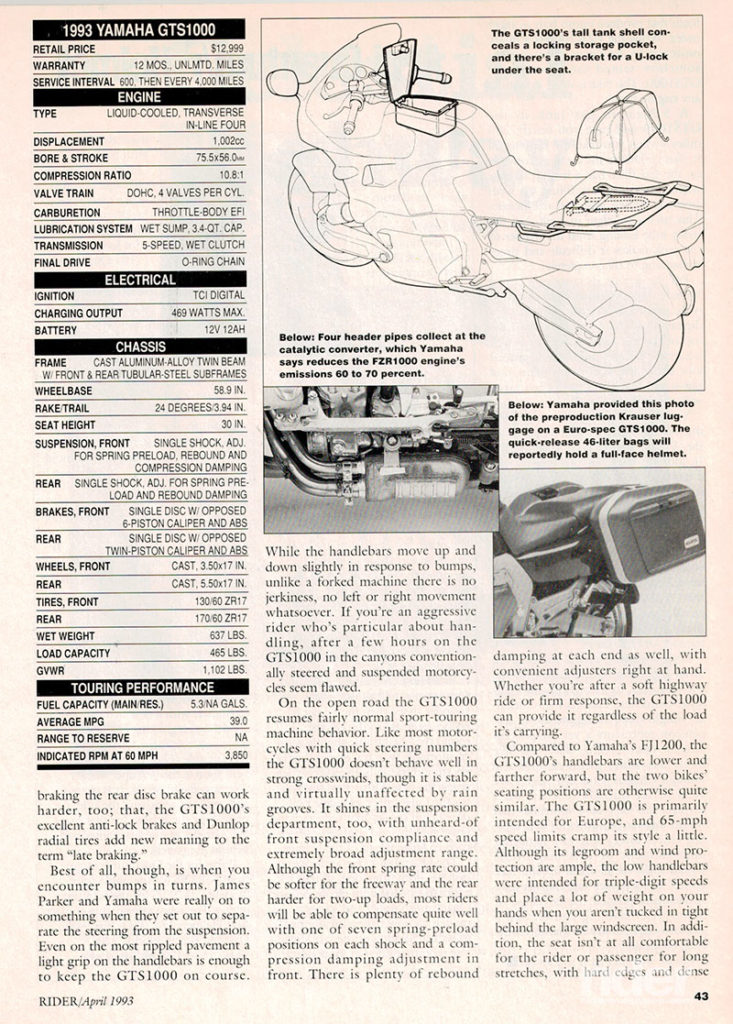

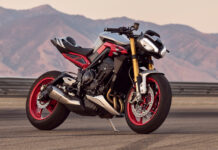
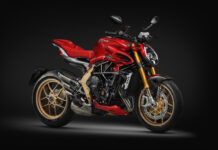
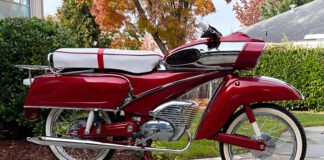



I owned one of these back in the late 90’s. Bought it with 3900 miles and paid a paltry $6500. It was a special and weird bike that I’m pleased to have owned. I’m confident the front suspension could have been incorporated at a lower cost on other bikes, but the production and take rates on the big GTS were simply too low for it to gain any mind share. In the end, it’s just a footnote in motorcycle history… and mine.
Such a shame that this opportunity was missed. I am lucky enough to own one and it is a dream under breaking and cornering. I also have a VFR750F L. In terms of which I enjoy the most it has to be the VFR simply because I just love the V Twin and its gear driven cams along with 6 gears. Maybe one day I’ll merge the two and have the perfect bike
Vfr = v4, not v twin, I may be mistaken, the RC36 in my shed certainly has 4 pots.
How many did they Build? Is it a Bike to own even now? I am a 6’5″ Dude that loves Motorcycles and appreciates almost every Bike as the purpose that they were built.// How is the performance? Is there a way to get another 20 HP without taking the Cases apart? I just love the look of the Bike. something about it. The Blackbird has the a similar effect, to me!
I have a rare California legal or all states if you prefer with a solid 93k on it and rides and runs like new.I have a slip on and adjustable suspension front and back.Im 65 and have owned like 150 plus bikes and this is a very fun bike
I’m just 2 years ahead of Duane at 67 who commented here and owns one of these and I’m thinking seriously about taking one out for a test drive today, It’s a 1993 with a 100k on it and looks to be in perfect shape from pictures. The bike just fascinates me and the price seems sweet at $2600. I have also been looking at a used BMW cycle that Ive heard nothing but good things about. I currently ride an 07 Harley Davidson Softail and love it but it’s grown …less exciting? It’s fun and it’s fast enough but I guess its just time for some variety to spice things up. (the HD stays, this will be an addition) Thanks for the reviews you guys and I wonder if I can take both of these bikes (the Yamaha and BMW) out for some San Diego canyon runs in the same day?